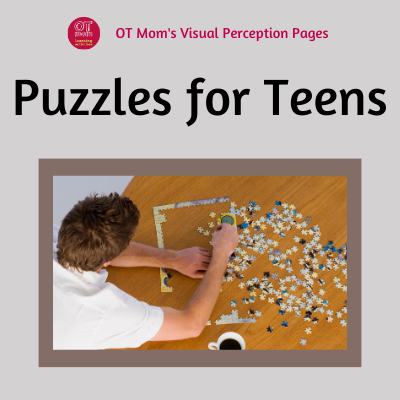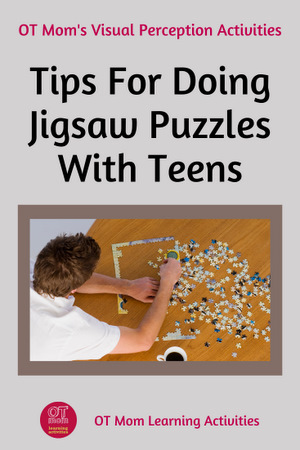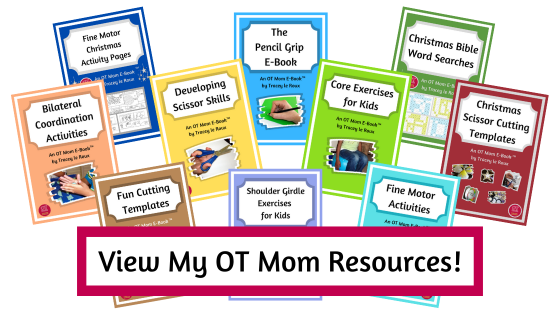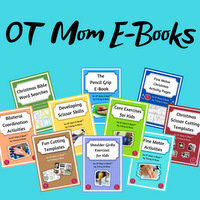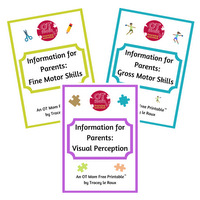- Home Page
- Visual Perception Activities
- Helping Your Teen Do Puzzles
Jigsaw Puzzles for Teens:
The Ultimate Guide To Boosting Their Skills!
Jigsaw puzzles for teens are more than just a pastime! They are a fantastic way to help your teen develop visual perception, spatial awareness and planning skills - all while having fun!
Keep on reading to find out how to choose the right jigsaw puzzle for the needs of your older child. And get tips to support your child if they struggle.
Have fun establishing new family traditions!
Key Takeaways For Busy Parents:
- Skill Development: Jigsaw puzzles for teens are not just for fun; they can also boost visual perceptual and spatial skills.
- Types of Puzzles: "Busy" puzzles with lots of small details can boost visual scanning and figure-ground discrimination skills; more "peaceful" puzzles may require more spatial orientation and visual discrimination skills.
- Family Fun: Make it a family activity to encourage participation.
- Quality Matters: Invest in good quality puzzles for durability. Choose puzzle piece count according to your teen's age and ability.
I sometimes link to products (#Ad) that are similar to those I use and love. If you do purchase something through my links, I will receive a small commission that helps support my site - thank you!
"Busy" Puzzles - Figure-Ground Perception and Scanning
Some puzzles are "busy" - filled with lots and lots of small objects. For example, the puzzle may show a library filled with books, or a bustling city street... these puzzles mostly use figure-ground perception and visual scanning skills.
To do a "busy" puzzle, you pick up a piece, see what colors and objects are on your piece, and then you visually scan the picture on the box until you spot the color and/object that matches your piece.
Then you place your piece in approximately the right spot and repeat with the next piece until you start getting pieces that fit together!
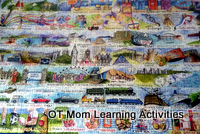 A busy puzzle with lots of small objects
A busy puzzle with lots of small objectsSometimes "busy puzzles" feel like they take a while to get going. It takes a little while to scan the picture and match up your piece to the picture. And then to find another piece that joins it! So it often takes a few sessions to feel like you are moving forward.
But it does get quicker and more satisfying as you progress.
Puzzles With Fewer Objects - Visual and Spatial Perception
Some puzzles are more "peaceful" (for lack of a better word) - the picture contains a few specific objects with a fairly quiet background.
When you do these puzzles, you are able to sort out the pieces into the various objects - for example, to complete the safari puzzle pictured here, you would be able to sort out the pieces into the different animals and the sky pieces.
Then you build one animal/section at a time, until you have completed the whole puzzle.
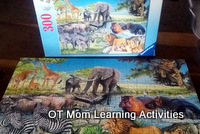 A puzzle with fewer, larger objects
A puzzle with fewer, larger objectsThis kind of puzzle has more of a visual discrimination and spatial orientation demand, as well as figure-ground perception. Although you may know from the color that you are working on, say, the elephant, you still need to figure how to orientate the pieces to complete the picture.
Depending on your child's visual perceptual and organizational skills, one type of puzzle may be more challenging than the other. The hardest type of puzzles are those with only a few large objects, with similar coloring, such as 2 elephants on a savanna backdrop.
Tips To Help Your Teen
- Invest in good quality puzzles. I really recommend Ravensburger puzzles for teens #Ad. They have lasted much longer than any other type of puzzle we have used. In most of their puzzles, the pieces are unique, which means they only fit correctly into one place. You want a puzzle that will stand up to being enjoyed every year, so get a good quality puzzle. Cloudberries are another fantastic company that focus on beautiful, sturdy puzzles for teens and adults. They ship internationally from the UK - well worth a look.
- Do the puzzles as a family.
Or make it YOUR puzzle, that you invite your kids to help you with! Set the puzzle out
somewhere that everyone can sit down and pop a piece in every now and
then, with no pressure. We build our puzzles on a
large piece of hard board that can be moved between the dining room
table and the coffee table. This reduces the pressure on your child to feel that they have to tackle this mammoth project all by themselves - it is a team effort.
- Take time to sort before you start building. First sort the pieces into edge pieces and non-edge pieces. If your puzzle has larger, defined objects on it, then sort the pieces into groups of similar colors - eg sky, water, buildings, to make it easier to start putting pieces together. Work together to sort - it does not need to be one person's task.
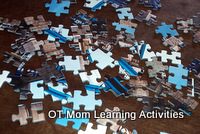 Mixed pieces
Mixed pieces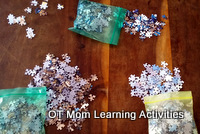 Sorted pieces
Sorted pieces- Making it a team effort means that if your older child/teen finds puzzles challenging, it is more fun to sit down and work on it if everyone in the family is involved. From looking out the edge pieces, to building the edge, to sorting pieces into the different objects, to building each object... everyone can get involved at some point.
- Almost every aspect of building a puzzle uses visual perceptual
skills, so invite your child to join you as YOU do the puzzle, and let
them see your enjoyment, and you should see their skills improve as they
take part.
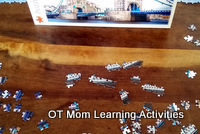
- Last tip - choose your puzzle wisely to make sure it is doable for a child who experiences visual perception challenges. For example, make sure there are enough different colors in the puzzle that you can differentiate the objects! A 1000 piece puzzle of a blue-grey dolphin jumping out of a blue sea, against a blue sky is really hard - ask me how I know - LOL!
Suggested Puzzles for Teens
Tweens may enjoy a 300 piece puzzle, progressing to 500 pieces as they improve their skills. Personally, our family of 3 teens enjoys 500-1000 piece puzzles - they take a few days for us to do as a family during a relaxed holiday week.
I really recommend Ravensburger#Ad and Cloudberries for their jigsaw puzzles - they stock a wide range of beautiful puzzles, and their pieces are sturdy and well made. Perhaps consider choosing a puzzle that can be framed when it is complete - this can make a beautiful addition to any room in the home!
My links above are simply for your convenience - you should be able to find suitable puzzles for teens in your local department store, in a thrift shop or maybe even borrow them from a friend! Some public libraries also loan out jigsaw puzzles.
I hope this page has helped to inspired you to help develop your child's visual perception and organization skills.
Jigsaw puzzles provide a unique opportunity for families to connect away from their screens. By choosing a puzzle that offers the right challenge, and working together as a teen, you are building lasting family memories as well as stronger cognitive skills.
What puzzle will your family build together first?
Check out this page for more visual perception ideas for older kids.
- Home Page
- Visual Perception Activities
- Helping Your Teen Do Puzzles
Share this page to help others!
Didn't find what you were looking for? Try a search of my site!
